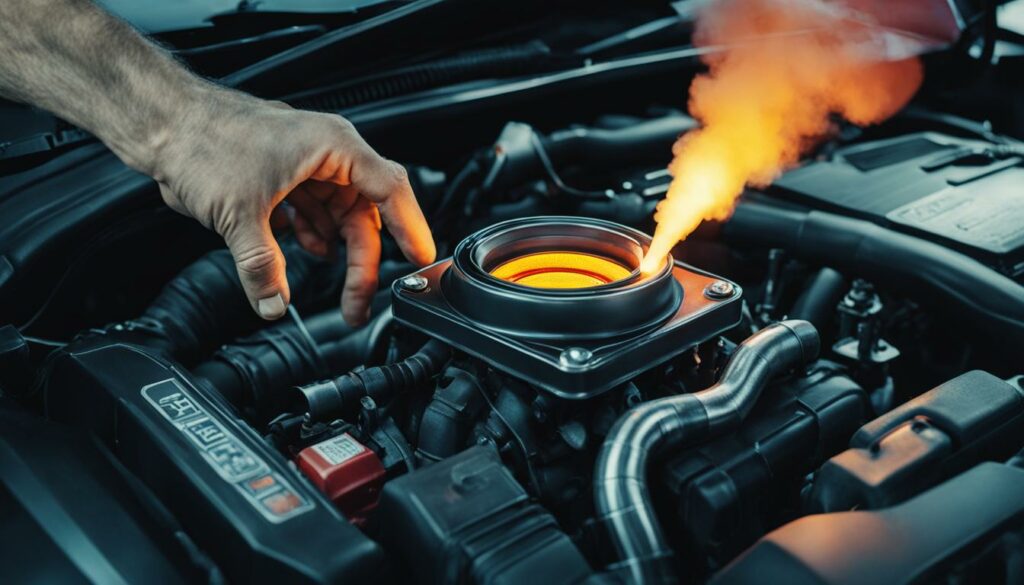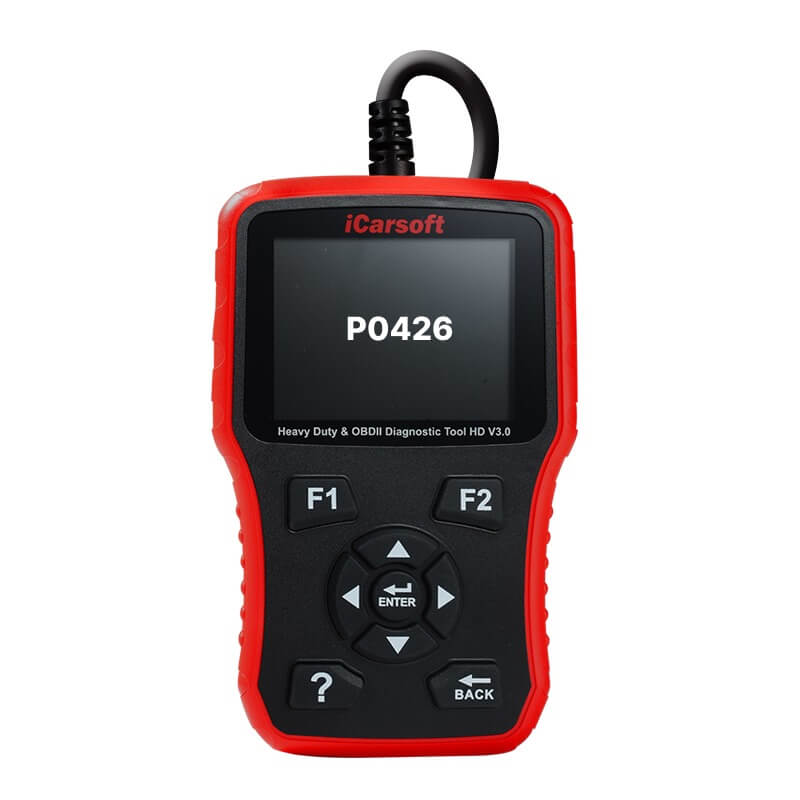P0426 – Catalyst Temperature Sensor Range/Performance
POSTED IN pcodes
The P0426 code is an OBD-II generic code that indicates a range or performance issue with the catalyst temperature sensor in a vehicle. The catalyst temperature sensor is responsible for monitoring the temperature of the catalytic converter, which plays a crucial role in reducing vehicle emissions and ensuring optimal engine performance.
When the data being sent by the oxygen sensor to the engine computer is not within the manufacturer’s parameters, the P0426 code is triggered. This code can result in a check engine light and may lead to physical damage to the catalytic converter if not addressed promptly. It can also cause issues such as decreased engine performance, stalling, and poor fuel mileage.
To diagnose the P0426 code, a mechanic will visually inspect the catalytic converter and oxygen sensors. They may need to replace a faulty sensor or repair damaged wiring. Resetting the engine computer can sometimes resolve an intermittent P0426 code. Repairs for the P0426 code may involve replacing the catalytic converter, oxygen sensors, or addressing other related trouble codes.
It is important to address the P0426 code promptly to maintain catalyst efficiency, engine performance, and ensure compliance with vehicle emission regulations. Professional automotive diagnostics and repairs are recommended for accurate diagnosis and resolution of the issue.
Key Takeaways:
- The P0426 code indicates a range or performance issue with the catalyst temperature sensor in a vehicle.
- This code can lead to physical damage to the catalytic converter and affect engine performance and fuel efficiency.
- A mechanic will visually inspect the catalytic converter and oxygen sensors to diagnose the issue.
- Repairs for the P0426 code may involve replacing the catalytic converter, oxygen sensors, or addressing other related trouble codes.
- Seeking professional automotive diagnostics and repairs is recommended for accurate diagnosis and resolution of the issue.
Definition and Causes of the P0426 Code
The P0426 code is a generic powertrain code that indicates a threshold problem with the bank 1 catalytic converter. This code is triggered when the data from the oxygen sensor does not meet the manufacturer’s parameters. Several factors can contribute to the occurrence of the P0426 code, including:
Buy tested tuning file for Adblue / EGR / DPF / Adblue off now!
- Faulty oxygen sensors
- Wiring problems
- An out-of-balance exhaust air/fuel mixture
- Issues with the PCM programming
When the P0426 code is present, it can manifest through various symptoms, serving as indicators of a potential issue. These symptoms may include:
- An illuminated check engine light
- Poor engine performance
- Decreased fuel economy
- Increased emissions
To further understand the P0426 code, it is important to analyze its causes and associated symptoms. By identifying these factors, proper diagnosis and repair can be initiated, ensuring optimal engine performance and emissions control.
Here’s an example of the P0426 code in action:
“My check engine light came on, and I noticed a decrease in my car’s performance. After having it diagnosed, the mechanic informed me that the P0426 code was present. It turned out that a faulty oxygen sensor was to blame for the issue.”
In situations like the one described, immediate attention to the P0426 code is advised in order to prevent further complications and maintain proper vehicle functionality.

Diagnosis of the P0426 Code
To diagnose the P0426 code, a mechanic will perform a visual inspection of the catalytic converter and oxygen sensors. This initial step is crucial in identifying any physical damage or loose connections that could be causing the issue. A faulty catalytic converter may produce an audible rattle when tapped with a small hammer, indicating a possible malfunction.
If the inspection reveals damaged oxygen sensor wiring, it may be necessary to replace the entire sensor. The mechanic will carefully assess the wiring for any signs of wear, corrosion, or disconnection. Replacing the oxygen sensor can help restore proper communication between the sensor and the engine computer, enabling accurate monitoring of the catalytic converter’s performance.
It’s important to note that the P0426 code can sometimes be intermittent, meaning it doesn’t consistently appear. In such cases, resetting the engine computer may temporarily resolve the issue. However, if the trouble code reappears, further diagnostics and testing may be necessary to pinpoint the exact cause of the problem.
Diagnosing the P0426 code involves a thorough examination of the catalytic converter and oxygen sensors, ensuring their proper functioning. Identifying any physical damage, loose connections, or faulty components is crucial in effectively addressing the issue and restoring the vehicle’s performance.
If the mechanic determines that additional diagnostics are needed, they may perform tests such as checking the oxygen sensor’s voltage output or inspecting the exhaust system for obstructions. These tests help uncover any underlying issues that could be causing the P0426 code and provide a comprehensive understanding of the vehicle’s overall condition.
Taking the time to accurately diagnose the P0426 code is essential in preventing further damage to the catalytic converter and ensuring optimal engine performance. By addressing the root cause of the code, mechanics can implement the appropriate repairs and enable the vehicle to meet necessary emission standards.
Common Mistakes and Severity of the P0426 Code
When it comes to diagnosing the P0426 code, one common mistake that mechanics often make is assuming that the catalytic converter is always the culprit. While a faulty catalytic converter can indeed trigger the P0426 code, it’s essential not to overlook the role of the oxygen sensor in this equation. The oxygen sensor is responsible for relaying crucial data to the engine computer, and if it malfunctions, it can lead to issues that trigger the P0426 code. Thus, it’s important to thoroughly inspect both the catalytic converter and the oxygen sensor before jumping to conclusions.
Now, let’s talk about the severity of the P0426 code. In general, the severity of this code is moderate, unless it causes adverse driving conditions associated with a faulty catalytic converter. A functional catalytic converter is essential for maintaining optimal vehicle performance and reducing emissions. Ignoring the P0426 code and failing to address any underlying issues can lead to critical damage to the vehicle’s exhaust and emissions system.
Severity of the P0426 Code:
- Moderate severity, unless associated with adverse driving conditions caused by a faulty catalytic converter
- Prolonged neglect can result in critical damage to the exhaust and emissions system
To ensure the best course of action and avoid unnecessary repairs, it’s crucial to conduct a comprehensive diagnostic process and accurately identify the source of the P0426 code. This requires a meticulous examination of the catalytic converter, oxygen sensor, and related components.
Next, we’ll delve into the specific diagnostic steps involved in addressing the P0426 code. But before we do, let’s take a moment to understand the importance of a thorough diagnosis to prevent potential setbacks and optimize the repair process.
“A proper diagnosis helps avoid unnecessary repairs and ensures an effective resolution for the P0426 code.”
Now that you’re aware of the common mistakes and severity associated with the P0426 code, let’s explore the diagnostic steps in detail.
Repairs for the P0426 Code
When encountering the P0426 code, there are several common repairs that can address the issue and restore your vehicle’s performance. These repairs focus on resolving the underlying causes of the code, ensuring proper functioning and optimal efficiency.
Here are some key repairs to consider:
- Replacement of Faulty Oxygen Sensor: A faulty oxygen sensor can often be the culprit behind the P0426 code. By replacing the faulty sensor with a new one, you can ensure accurate readings and data transmission to the engine computer.
- Addressing Wiring Problems: Wiring issues can disrupt the communication between the oxygen sensor and the engine computer. Inspecting and repairing any damaged or loose wiring can help resolve the P0426 code.
- Balancing the Exhaust Air/Fuel Mixture: An out-of-balance air/fuel mixture can contribute to the P0426 code. Adjusting the fuel system, such as cleaning or replacing fuel injectors, can help achieve the optimal mixture and improve catalytic converter performance.
- Ensuring Proper Functioning of the PCM: The Powertrain Control Module (PCM) plays a crucial role in regulating various components of the vehicle’s engine system. Ensuring that the PCM is functioning correctly can help address the P0426 code.
It is also important to check for any associated trouble codes when diagnosing and repairing the P0426 code. Associated trouble codes can provide valuable insights into the underlying root cause of the problem, helping to guide the repair process.
Please note that the specific repairs required may vary depending on the make and model of your vehicle. It is always recommended to consult with a professional mechanic or automotive technician for accurate diagnosis and appropriate repairs.
If professional assistance is unavailable, there is an alternative solution to permanently remove the P0426 code. By uploading the Engine Control Unit (ECU) file to a portal, the code can be eliminated. However, it’s important to note that this solution should only be considered after thorough research and understanding of the potential implications.

| Common Repairs for P0426 Code | Associated Trouble Codes |
|---|---|
| Replacement of Faulty Oxygen Sensor | P0420 – Catalyst System Efficiency Below Threshold |
| Addressing Wiring Problems | P0141 – O2 Sensor Heater Circuit Malfunction (Bank 1, Sensor 2) |
| Balancing the Exhaust Air/Fuel Mixture | P0171 – System Too Lean (Bank 1) |
| Ensuring Proper Functioning of the PCM | P0606 – PCM Processor Fault |
Conclusion
The P0426 code indicates a threshold problem with the vehicle’s bank 1 catalytic converter. This code can have a significant impact on engine performance and emissions. Therefore, it is crucial to diagnose and repair it promptly.
To diagnose the P0426 code, a visual inspection of the catalytic converter and oxygen sensors should be conducted. This involves checking for loose connections and physical damage. Diagnostic steps also include addressing any wiring issues and ensuring a balanced exhaust air/fuel mixture.
Common repairs for the P0426 code involve replacing faulty components, such as oxygen sensors, that may be causing the catalyst temperature sensor range/performance issue. Seeking professional assistance is recommended to ensure accurate diagnosis and repair. However, if professional help is not available, an alternative solution is the permanent removal of the P0426 code by uploading the Engine Control Unit (ECU) file to a portal.
In conclusion, it is essential to take the necessary steps to address the P0426 code in order to optimize engine performance and reduce emissions. Diagnosing the issue, conducting proper repairs, and seeking professional assistance when needed will ensure the vehicle operates at its best.
FAQ
What is the P0426 code?
The P0426 code is an OBD-II generic code indicating a threshold problem with the vehicle’s bank 1 catalytic converter. It is triggered when the data being sent by the oxygen sensor to the engine computer is not within the manufacturer’s parameters.
What are the symptoms of the P0426 code?
Symptoms of the P0426 code can include an illuminated check engine light, poor engine performance, decreased fuel economy, and increased emissions.
How is the P0426 code diagnosed?
To diagnose the P0426 code, a mechanic will perform a visual inspection of the catalytic converter and oxygen sensors. They will check for any physical damage or loose connections. Additional diagnostics and testing may be required in some cases.
What are common mistakes when diagnosing the P0426 code?
One common mistake is assuming that the catalytic converter is always to blame. The oxygen sensor plays a crucial role in relaying data to the engine computer, and a faulty sensor can cause issues.
How severe is the P0426 code?
The severity of the P0426 code is generally moderate, unless it is causing adverse driving conditions associated with a faulty catalytic converter. Prompt investigation and repair are recommended to prevent any critical damage to the vehicle’s exhaust and emissions system.
What are the common repairs for the P0426 code?
Common repairs for the P0426 code include replacing a faulty oxygen sensor, addressing wiring problems, balancing the exhaust air/fuel mixture, and ensuring proper functioning of the PCM. It is important to check for any associated trouble codes, as they can provide insights into the actual root cause of the problem.
Can the P0426 code be permanently removed?
If professional assistance is unavailable, an alternative solution is the permanent removal of the P0426 code by uploading the Engine Control Unit (ECU) file to a portal. However, this should only be considered after all necessary repairs and diagnostics have been performed.


